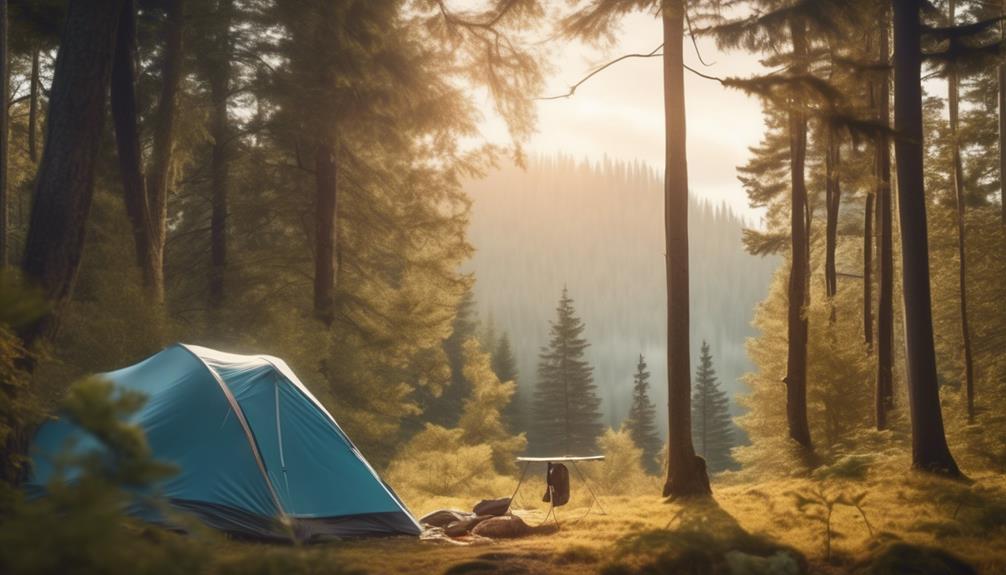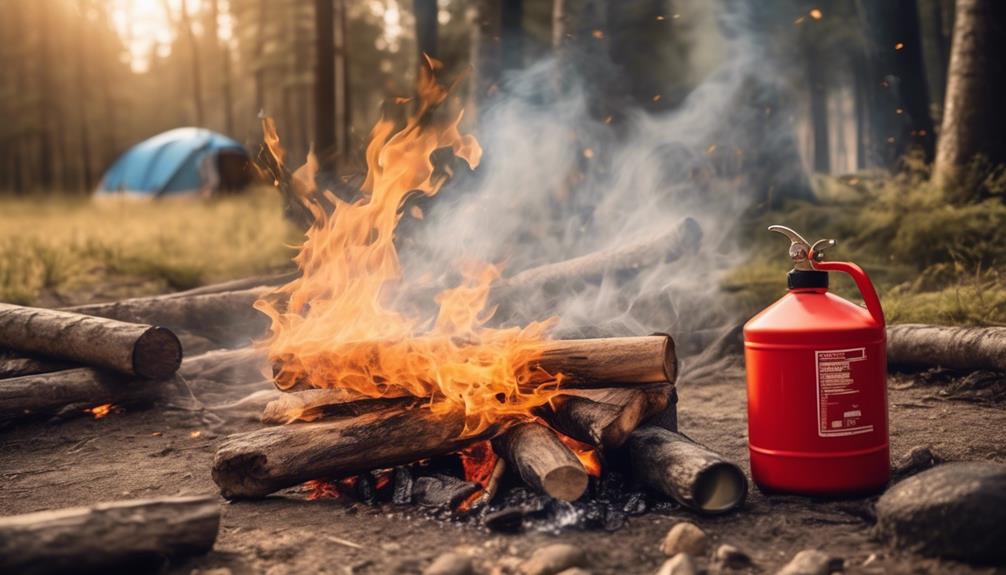Top Solo Camping Safety Tips: A How-To Guide
Have you ever wondered how you can ensure your safety while embarking on a solo camping adventure? In the wilderness, being prepared and knowledgeable about potential risks can make all the difference.
From essential gear to wildlife awareness, there are crucial tips and techniques that can help you stay safe during your solo camping trips.
You don't want to miss out on these valuable insights that could potentially save your life.
Essential Gear

When camping solo, it's essential to pack light, but make sure you have all the necessary gear for safety and comfort. One of the most important pieces of gear is a reliable tent. Look for one that's lightweight, easy to set up, and provides good protection from the elements.
A sleeping bag suitable for the expected temperatures is crucial for a good night's rest. A sleeping pad can also add comfort and insulation from the cold ground.
Don't forget a first aid kit, including essential items like bandages, antiseptic wipes, and any personal medications you may need. A multi-tool or knife is invaluable for various tasks around the campsite and can be essential in emergencies.
Another essential piece of gear is a reliable and bright headlamp, as it's crucial for moving around in the dark, especially when setting up camp or using the bathroom at night. A portable stove and fuel are essential for cooking meals and boiling water.
It's also important to bring enough food and extra water for the duration of your trip, as well as a water purification method in case you run out. For navigation, a map and compass are essential, even if you plan to rely on a GPS device or smartphone.
Lastly, a whistle and mirror can be vital for signaling for help if you get lost or injured. These essentials will help ensure your safety and comfort during your solo camping adventure.
Campsite Selection
To ensure a safe and enjoyable solo camping experience, carefully select your campsite based on factors such as terrain, weather conditions, and proximity to water sources. When choosing a campsite, prioritize level ground to pitch your tent. Avoid areas prone to flooding or with the potential for falling debris. Additionally, consider the terrain for any natural windbreaks or shelter from the elements. Look for a spot with good drainage to prevent water from pooling around your tent, and clear the area of any sharp rocks or branches that could puncture your gear or cause injury.
Evaluate the weather conditions and choose a campsite that offers natural protection from the elements. Seek out areas with tree cover for shade and potential shelter from rain or strong winds. However, be mindful of dead or damaged trees that could pose a hazard. Make sure your chosen campsite isn't in a high-risk area for lightning strikes and, if possible, avoid camping near ridge tops or exposed areas during stormy weather.
Proximity to water sources is crucial, but ensure you're at a safe distance to prevent flooding or water seeping into your tent. Avoid setting up camp too close to rivers or streams, as water levels can rise unexpectedly. If you plan to use a portable stove or build a campfire, choose a spot away from overhanging branches and dry vegetation to minimize fire risk.
Wildlife Awareness

Be aware of wildlife in the area and take necessary precautions to minimize encounters while solo camping. Before setting up your campsite, familiarize yourself with the types of wildlife that inhabit the area. Research the local fauna and learn about any potential dangers or encounters you may face. Keep in mind that some wildlife is more active during specific times of the day, so plan your activities accordingly.
When storing food, make sure to use airtight containers and store them away from your sleeping area. Hanging food from a tree branch or using bear-proof canisters can also deter animals from raiding your supplies. Additionally, avoid bringing strong-smelling foods as they can attract wildlife.
During your camping trip, make noise while hiking or walking to alert wildlife of your presence. This can help prevent surprise encounters and reduce the likelihood of startling an animal. Stay on designated trails and avoid venturing into dense vegetation where animals may be hiding.
If you do encounter wildlife, remain calm and don't run. Back away slowly while maintaining eye contact with the animal. It's important to give wildlife space and not approach or attempt to feed them. Always carry bear spray or other deterrents recommended for the specific wildlife in the area and know how to use them effectively.
Emergency Preparedness
In the event of an emergency while solo camping, prioritize familiarizing yourself with the nearest exit routes and emergency contact information for the area. Being prepared can make all the difference in a crisis.
Here are some essential emergency preparedness tips to keep in mind:
- Create an Emergency Plan: Before embarking on your solo camping trip, map out an emergency plan. Identify the nearest medical facilities, ranger stations, and emergency services. Make sure to inform someone trustworthy of your itinerary and expected return date.
- Pack a First Aid Kit: Always carry a well-stocked first aid kit and know how to use its contents. Be prepared to handle minor injuries and manage medical situations until help arrives.
- Carry Communication Devices: Bring a fully charged cell phone, a portable charger, and a whistle. Additionally, consider investing in a personal locator beacon (PLB) or satellite messenger in case of emergencies.
- Stay Informed about Weather Conditions: Keep an eye on weather forecasts. Sudden changes in weather can pose significant risks, especially when camping in remote areas. Be prepared to adjust your plans accordingly.
- Know How to Signal for Help: Learn how to signal for help using visual and auditory cues. Carry a flashlight, mirror, or whistle to attract attention if needed.
Being proactive and prepared for emergencies can make a huge difference in ensuring your safety while solo camping.
Fire Safety

Once you have ensured your emergency preparedness, turn your attention to fire safety when camping solo. Building and maintaining a campfire can provide warmth, light, and a means to cook food, but it also presents potential hazards.
First, ensure that the campfire site is located in a clear, open area away from overhanging branches, dry grass, or any flammable materials. Keep a shovel, bucket of water, and a fire extinguisher nearby to quickly address any unforeseen incidents.
Before starting a fire, check the current fire regulations and weather conditions in the area and obtain any necessary permits. When lighting a fire, use proper fire starters like matches or lighters and never use gasoline or other accelerants.
Once the fire is burning, never leave it unattended and always fully extinguish it before leaving the campsite or going to sleep. To extinguish the fire, pour water over the embers and stir them with a shovel to ensure everything is fully out. It's crucial to respect fire safety measures to prevent accidental wildfires and ensure your own safety.
Lastly, familiarize yourself with the signs of heat exhaustion and heat stroke, and always keep a first-aid kit on hand in case of any burns or injuries. By following these fire safety tips, you can enjoy the warmth and comfort of a campfire while minimizing the associated risks.
Navigation and Communication
Consider bringing a reliable map and compass to ensure you can navigate your surroundings effectively while camping solo. When venturing out into the wilderness alone, it's crucial to have the tools to find your way and communicate in case of an emergency.
Here are some navigation and communication tips to keep in mind:
- Plan Your Route: Before setting out, plan your route and familiarize yourself with the area. Mark significant landmarks on your map to keep track of your location.
- Learn to Use a Compass: Take the time to learn how to use a compass accurately. Understanding how to read a compass can prevent you from getting lost and help you find your way back to your campsite.
- Signal Devices: Bring a whistle, signal mirror, or flashlight to attract attention if you get lost or need assistance. These simple tools can make a significant difference in an emergency situation.
- Emergency Communication: Carry a satellite messenger or personal locator beacon (PLB) for emergency communication. These devices can send an SOS signal with your GPS location, alerting search and rescue teams to your whereabouts.
- Stay Informed: Stay updated on weather forecasts and any potential hazards in the area. Being aware of changing conditions can help you make informed decisions about your route and camping activities.
Frequently Asked Questions
How Can I Protect My Food From Bears and Other Wildlife While Solo Camping?
To protect your food from bears and wildlife while solo camping, use bear-proof canisters or hang food in a bear bag at least 10 feet off the ground and 4 feet from the tree trunk. Never keep food in your tent.
What Should I Do if I Encounter a Snake or Other Dangerous Animal While Hiking to My Campsite?
If you encounter a snake or other dangerous animal while hiking to your campsite, slowly back away and give it space. Avoid sudden movements and loud noises. Carry a snakebite kit and know how to use it.
Are There Any Specific Solo Camping Safety Tips for Women?
When camping solo as a woman, always trust your instincts, let someone know your plans, and pack self-defense items. Be aware of your surroundings, stay on marked trails, and avoid isolated areas. Stay safe!
How Can I Ensure My Personal Safety While Camping Alone in a Remote Area?
To ensure personal safety while camping alone in a remote area, always share your itinerary, pack essentials, and have a first aid kit. Stay aware of your surroundings, trust your instincts, and avoid risky situations.
What Are Some Essential Self-Defense Techniques for Solo Camping?
To ensure your safety while camping solo, learn essential self-defense techniques like basic striking and grappling moves. Carry a whistle or personal alarm, and always trust your instincts. Consider taking a self-defense class for additional confidence.
Conclusion
Now that you have the essential gear and knowledge of solo camping safety, you're ready to embark on your adventure. Remember to always select a safe campsite, be aware of wildlife, and have an emergency plan in place.
Practice fire safety and ensure you have proper navigation and communication tools. With these tips in mind, you can have a safe and enjoyable solo camping experience.
Happy camping!
